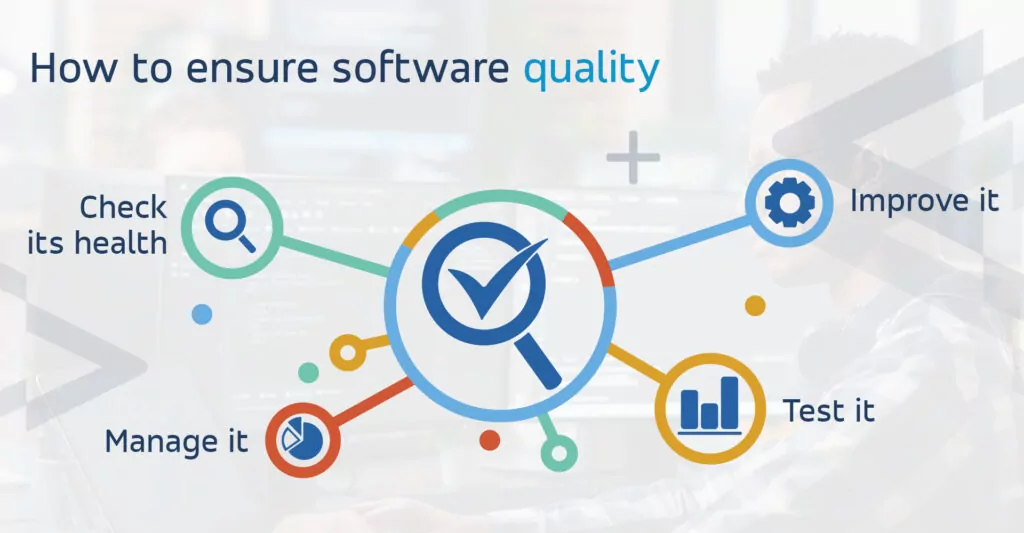No matter if you build your software in-house or with the help of a software company, you have to be able to ensure – and verify – its quality. If you keep the checkups regular, your application will be easier and less costly to maintain and develop. Otherwise, errors might build up to the extent that you’d buy a lemon investing further in the product.
What is software quality?
Let’s get down to brass tacks, then. Software quality means that your digital product works. But (sic) wait, there’s always a but: poor code can also work. Thus, a deftly developed app functions correctly, can be developed further, and is less costly to keep alive. Our app can work faster and more efficiently with quality code. Thus, providing a high software standard should be an integral part of the development process. As always, its spectrum depends on the very situation, such as the project’s budget, business requirements, or timeline.
Why is quality so important?
The quality of your software can affect your company in so many ways. It impacts brand image, user satisfaction, and clients’ willingness to use your software. Low-quality software can even pose a risk to the business.
What’s more, high-quality software is easier and cheaper to maintain and develop further, adding new features, etc. On the other hand, poor quality programming inevitably leads to technical debt and, in extreme cases, a moment when you can’t introduce any changes at all, despite the fact that they are needed.

When quality isn’t important (can’t believe we’re saying it)
Even so, you have to bear in mind that to achieve the level where your code is easier and cheaper to maintain; first you have to invest more time and money to create and test it. And often, at the beginning of product building, both resources are sparse. Hence, sometimes it’s even better not to bring an app to perfection but to give it a test drive when it’s still underdeveloped. If that’s your case, don’t worry, we can take care of your code and fix it later on.

Four ways to ensure software quality
We’ve identified four software quality areas to invest your energy (and resources).
1. Check its health
First, you need to diagnose your software accurately. Health checks are usually:
- Performed once for a particular reason, such as when a new version is released, whenever any problem occurs, or the product grows rapidly in terms of users or in the effect of mergers.
- Conducted periodically, such as security testing.
We’ve already described application health checks in detail, so let’s move to the second point without further ado.
2. Test it
Apart from occasional health checks, the most efficient way to ensure software quality is to test it. Tests should be an inherent part of the development process and thus performed day in, day out.
There is a variety of test types:
- code quality assurance,
- unit testing,
- integration testing,
- performance testing,
- stress testing,
- user acceptance testing,
- and regression testing.
Not to delve into the details, as we’ve got a separate blog post on tests, in which we expand on all the above types separately.
3. Improve it
As we’ve already mentioned, there’s no time to rest on your laurels regarding software development. Once your app is built, you have to optimize it, ensure it’s always up-to-date, meets the latest standards, and satisfies changing consumer behavior.
Code writing is one thing, but your development process may also need improvement. For example, it might bring test automation, unit tests, CI/CD, and code reviews.
4. Manage it
Last but not least, you have to keep the project under wraps. To do so, establish a software quality management process and its objectives.
The following list might be of help in process-based management, where following specifications should be taken into account:
- Quality standards, i.e., what it means that defined requirements are met
- Metrics, such as bug density, crash rate, percentage of passed unit tests, number of regressions
- Roles and responsibilities, such as who approves test cases
- Timeframes and deadlines
- How to report and document tasks and their results, for example, in the ticketing system or XML files generated by the NUnit tool (which is often our case)

Enhancing software quality: examples
Now, let’s take a look at examples from our backyard, which will present how important it is to take care of software quality.
1. A complex approach to testing
Our client’s application consisted of numerous modules. Changes in separate modules often lead to bugs in other parts of the app that seemingly weren’t connected. The company started experiencing more and more errors of this kind, called regression bugs.
We investigated the whole development process and proposed a complex test plan to find a way out of the crisis situation. It took the form of a document, where we described, among others:
- The scope of testing
- Code Quality Assurance procedures
- Tests that will be run: System Testing, Stability Testing, User Acceptance Testing, Regression Testing, Installation testing
- Test environments
- Test execution in cycles
- Test metrics: quantitative and qualitative
- Test result documentation
On a side note, we’d like to highlight that business people frequently aren’t aware of the importance of regression testing. Mainly due to the fact that it appears non-obvious. They assume that if a feature has been tested once and works fine, it shall work further on.
2. The need for test automation
One of our clients had a mobile application, which they sold to their business partners, who then distributed it amongst the end users under their own brand. Partners frequently required adding custom features or introducing some app changes, while keeping the core of the app unchanged. Each app had 3 versions: development, staging, and production. As a result, tens of applications had to be maintained day in, day out. Soon, it became impossible to test all versions manually.
To minimize the effort needed to perform tests and the number of human errors during manual testing, we offered our client to build automated mobile app tests. So that unit tests, for example, could be performed by a continuous integration tool.
An overview
Regular health checks, tests, improvements, and a well-structured process will help you ensure your software quality. Even so, one day, you may end up caught between a rock and a hard place, having to decide whether to maintain or rewrite the code. We all know, there’s never a good time to do the latter. 😉 If you’re not sure whether you’ve reached this point already, we can give you a helping hand during our consultations we provide free of charge.





